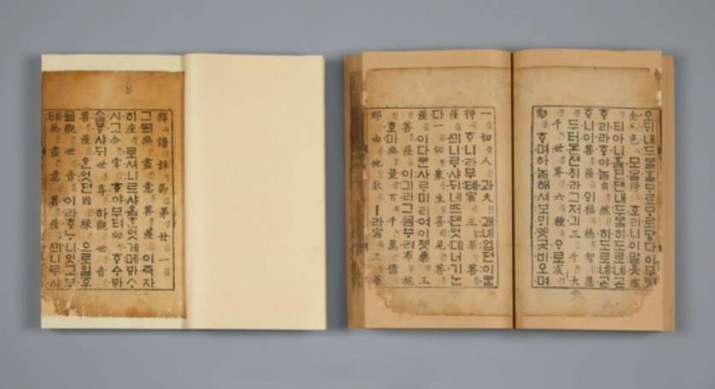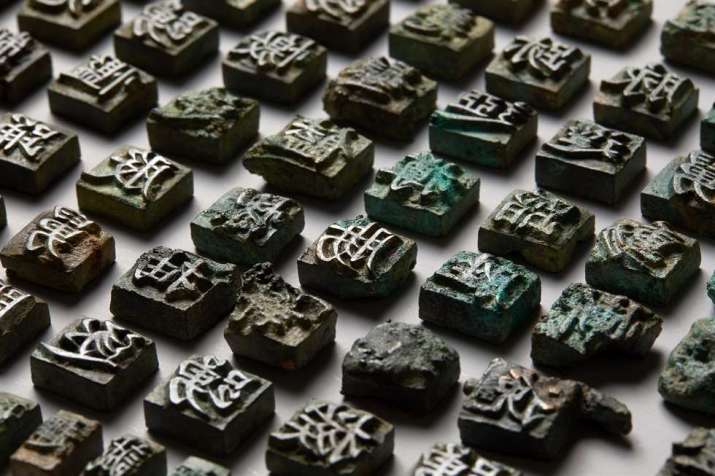NEWS
Korean Buddhist Manuscripts Exhibited for Hangul Day
 Seokbosangjeol Volumes 20 and 21. From koreajoongangdaily.com
Seokbosangjeol Volumes 20 and 21. From koreajoongangdaily.comSouth Korea celebrated Hangul Day, named for the Korean alphabet, on 9 October with a number of national observances, including a display of Buddhist manuscripts pronted using metal movable type. Central to the observance has been Volumes 20 and 21 of Seokbosangjeol on display as a permanent exhibit at the National Museum of Korea since 30 September. The works are part of a collection donated by the late former chairman of Samsung Group, Lee Kun-hee (1942–2020).
Seokbosangjeol is the first Buddhist text to be written in the newly developed Hangul script in 1447. It was commissioned by Prince Suyang (1417–68), who later became King Sejo, the seventh king of Joseon, in honor of his mother, Queen Soheon, who had just passed away. Queen Soheon (1395–1446) had been a devout Buddhist in an otherwise predominantly Confucian kingdom during the Joseon dynasty (1392–1910).
The Hangul alphabet was developed during the life of Queen Soheon by her husband, King Sejong (1392–1450). The alphabet and early writings using it have been a national treasure for Korea ever since.
Jang Jin-won, a research professor at Dongguk University’s Institute for World Buddhist Studies, noted that Seokbosangjeol is significant in that “it’s the first book that was created after the creation of hangul to check whether it was made correctly or if there were any errors.” He added: “[The] Buddha’s sermons are also included, which is different from existing literature on Buddhism. It also attests that the royal court during that time depended heavily on the Buddhist community.” (Korea JoongAng Daily)
A total of 24 volumes of Seokbosangjeol are believed to have been published, however several are lost. Volumes 6, 9, 13, and 19 are in the collection of the Library of Korea. Volumes 23 and 24 are at Dongguk University’s Central Library. Volumes 20 and 21, now on display at the National Museum of Korea, have never previously been shown to the public.
 Movable metal type blocks from 1434. From koreatimes.co.kr
Movable metal type blocks from 1434. From koreatimes.co.krIn addition to Seokbosangjeol, 152 metal type blocks believed to date to the 15th century are also on display for the first time, having been held in storage at the National Museum of Korea since 1931.
According to museum officials, it was difficult to study the blocks due to a lack of existing similar blocks for comparison. However, after the discovery of a stash of some 1,600 movable blocks in June, researchers were able to begin a comparative study. At this time, they have yet to conclude definitively on the provenance of the two sets of metal blocks.
“We were able to compare the components of the metal type found recently and the ones we had, and both are from the same period,” said Kim Dong-woo, a researcher from the National Museum of Korea. “We also checked the font and the size with the book printed using Gapinja type, which was also donated by former Chairman Lee Kun-hee. Many of the characters were the same.” (Korea JoongAng Daily)
Kim noted that the documents and history around them had helped to unlock the complex history of Buddhism on the Korean Peninsula, which arrived in 372 CE and was officially recognized as the state religion by the Silla kingdom of in 552. Later, in the Joseon dynasty, Neo-Confucian ideals overcame Buddhism, leading to persecution of Buddhism.
“In addition to the research value of hangul, Seokbosangjeol is also highly valued for the study of the culture of Buddhism,” said Kim from the museum. “Although the Joseon dynasty is often known as a Confucian country, the tradition of Goryeo remained in the royal family and Buddhist culture continued, and Seokbosangjeol proves this. There were many people who followed Buddhism in the royal family in the early Joseon dynasty.” (Korea JoongAng Daily)
“It is an important relic that showcases the development of Korea’s movable metal type casting technology that continued to develop since Jikji Simche Yojeol (1377), the book historians believe to be the first known use of movable metal type,” said Lee Seung-cheol, a researcher at the UNESCO International Centers for Documentary Heritage. (Korea JoongAng Daily)
According to 2015 census data, most people in South Korea—56.1 per cent—hold no religious affiliation. Christians make up the largest segment of the population with 27.6 per cent, with Buddhists making up 15.5 per cent.
See more
National museum marks Hangul Day with exhibit of Buddhist manuscripts (Korea JoongAng Daily)
Early Joseon-era Buddhist scripture in Hangeul unveiled among Lee Kun-hee's donations (The Korea Times)
Related news from Buddhistdoor Global
UPDATE: South Korean Buddhist Temple Enshrines Buddha Statue Gift from India
Indian PM Modi Emphasizes the Role of Buddhist Diplomacy at Buddha Jayanti Celebration
Vesak Celebration: Vatican’s Message Asks Buddhists and Christians to Promote Peace, Nonviolence
South Korea Seeks UNESCO World Heritage Status for Seven Mountain Temples
Korean Archaeologists Unearth Rare 9th Century Buddha Statue
Related features from Buddhistdoor Global














